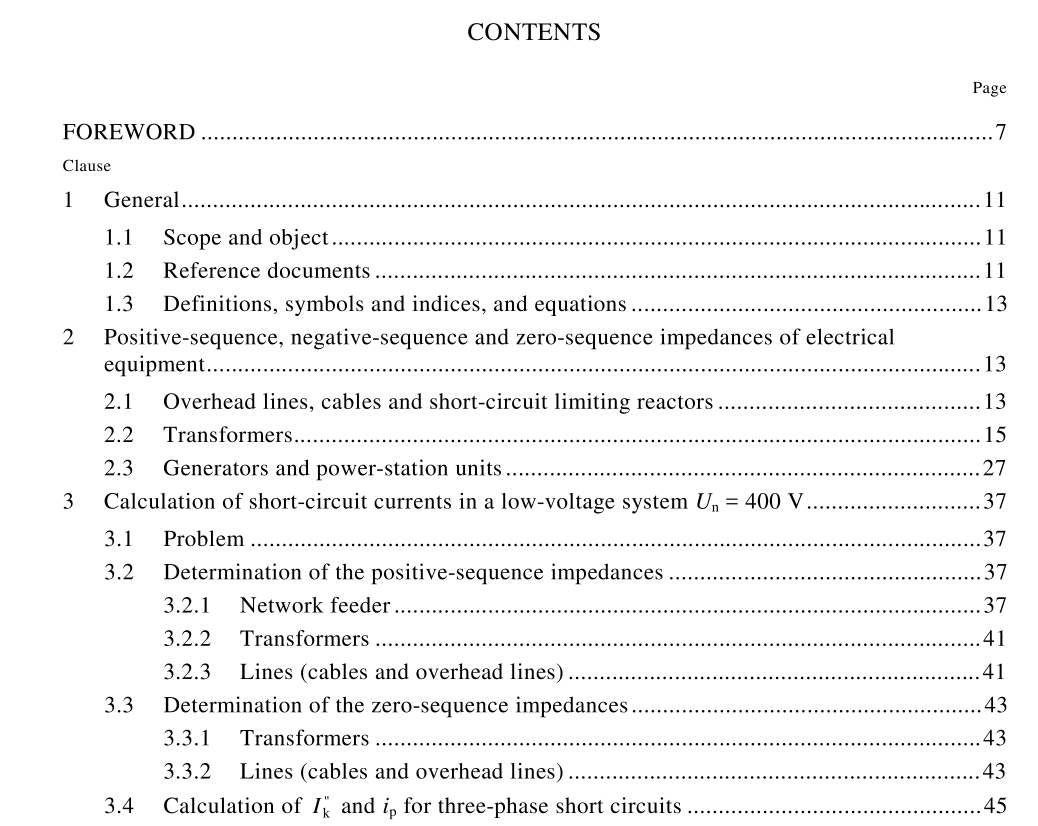IEC TR 60909-4 pdf download

IEC TR 60909-4 pdf download.Short-circuit currents in three-phase a.c. systems
1 General
1.1 Scope and object
This part of IEC 60909 is a technical report intended to give help for the application of IEC 60909-0 for the calculation of short-circuit currents in 50 Hz or 60 Hz three-phase a.c. systems. This technical report does not include additional requirements but gives support for the modelling of electrical equipment in the positive-sequence, the negative-sequence and the zero- sequence system (clause 2) and the practical execution of calculations in a low-voltage system (clause 3), a medium-voltage system with asynchronous motors (clause 4) and a power-station unit with its auxiliary network feeding a large number of medium-voltage asynchronous motors and low-voltage motor groups (clause 5). The three examples given in clauses 3, 4 and 5 are similar to those given in IEC 60909 (1988) but they are revised in accordance with IEC 60909-0, which replaces it. A subclause is added to the example in clause 3 to give a comparison between the results found with the application of the equivalent voltage source at the short-circuit location following the procedure given in IEC 60909-0 on the one hand, and results found with the superposition method on the other hand, taking into account different load-flow conditions before the short circuit. Clause 6 of this technical report gives the circuit diagram and the data of a test network and the results for a calculation carried out in accordance with IEC 60909-0, to offer the possibility for a comparison between the results found with a digital program for the calculation of short-circuit currents and the given results for p1 k1 k b p k in a high-voltage network with power-station units, generators, asynchronous motors and lines in four different voltage levels 380 kV, 110 kV, 30 kV and 10 kV.
Equations for the calculation of the positive-sequence and the zero-sequence system impedances of overhead lines with one or two parallel circuits (double circuit line) and without or with one or two earth wires are given in IEC 60909-2. The negative-sequence impedance is equal to the positive-sequence impedance. The measurements to find the positive-sequence and the zero- sequence impedances of cables with sheath, shielding and armouring are similar to those given in figure 1. Examples are given in IEC 60909-2. In the case of the zero-sequence impedance, the earthing of the sheath or the shielding or the armouring is important as well as the number of parallel cables. In the case of low-voltage four-core cables the cross-section of the earthed core has an influence on the zero-sequence impedance. Figure 2 demonstrates the meaning and the principal measurement of the positive-sequence and the zero-sequence impedance of a three-phase a.c. short-circuit limiting reactor.
If the magnetic coupling between the three coils without or with iron core is small, the zero- sequence impedance Z (0)R is approximately equal to the positive-sequence impedance Z (1)R . When calculating short-circuit currents in high-voltage systems, it is often sufficient to use the reactance only. 2.2 Transformers Unit transformers of power-station units are also dealt with in 2.3. Network transformers have two or three or even more three-phase windings. Figure 3 gives an example for the positive-sequence and the zero-sequence system impedances of a two-winding transformer with the vector group YNd5. In the case of three-winding transformers (examples are given in table 3b of IEC 60909-2), it is necessary to measure three different impedances and then to calculate the three impedances of the equivalent circuit in the positive-sequence or the zero-sequence system of the transformer, see 3.3.2 of IEC 60909-0 and the example at the end of this clause.









